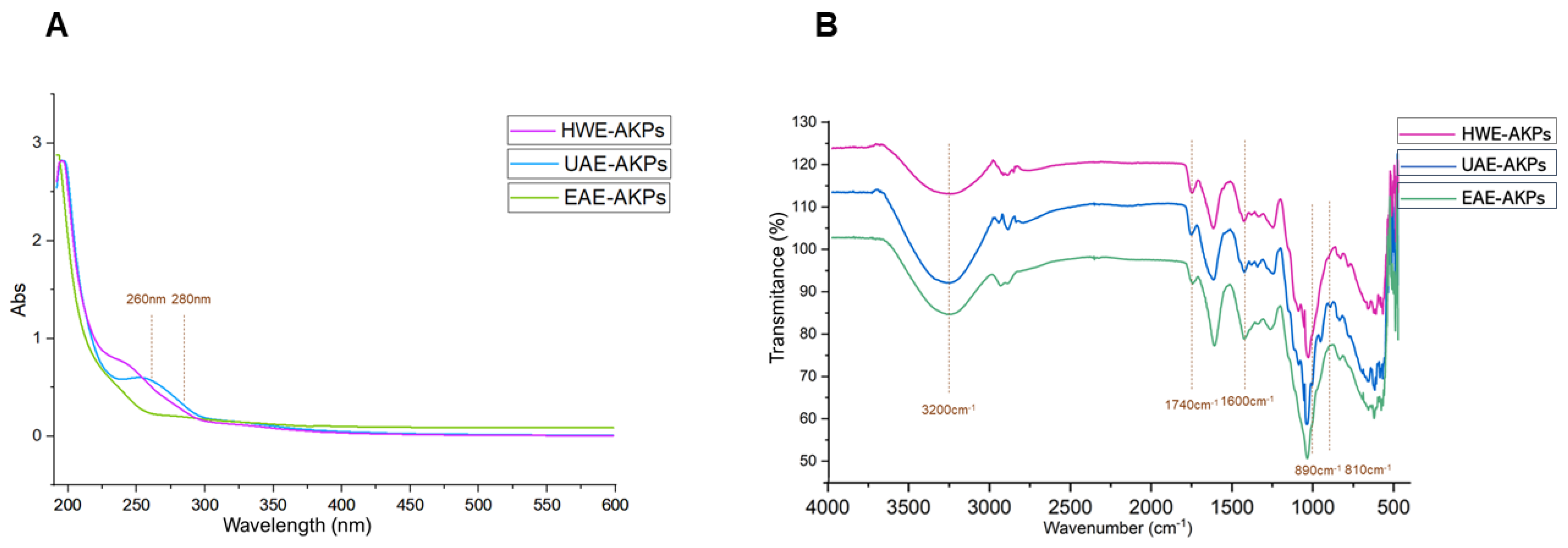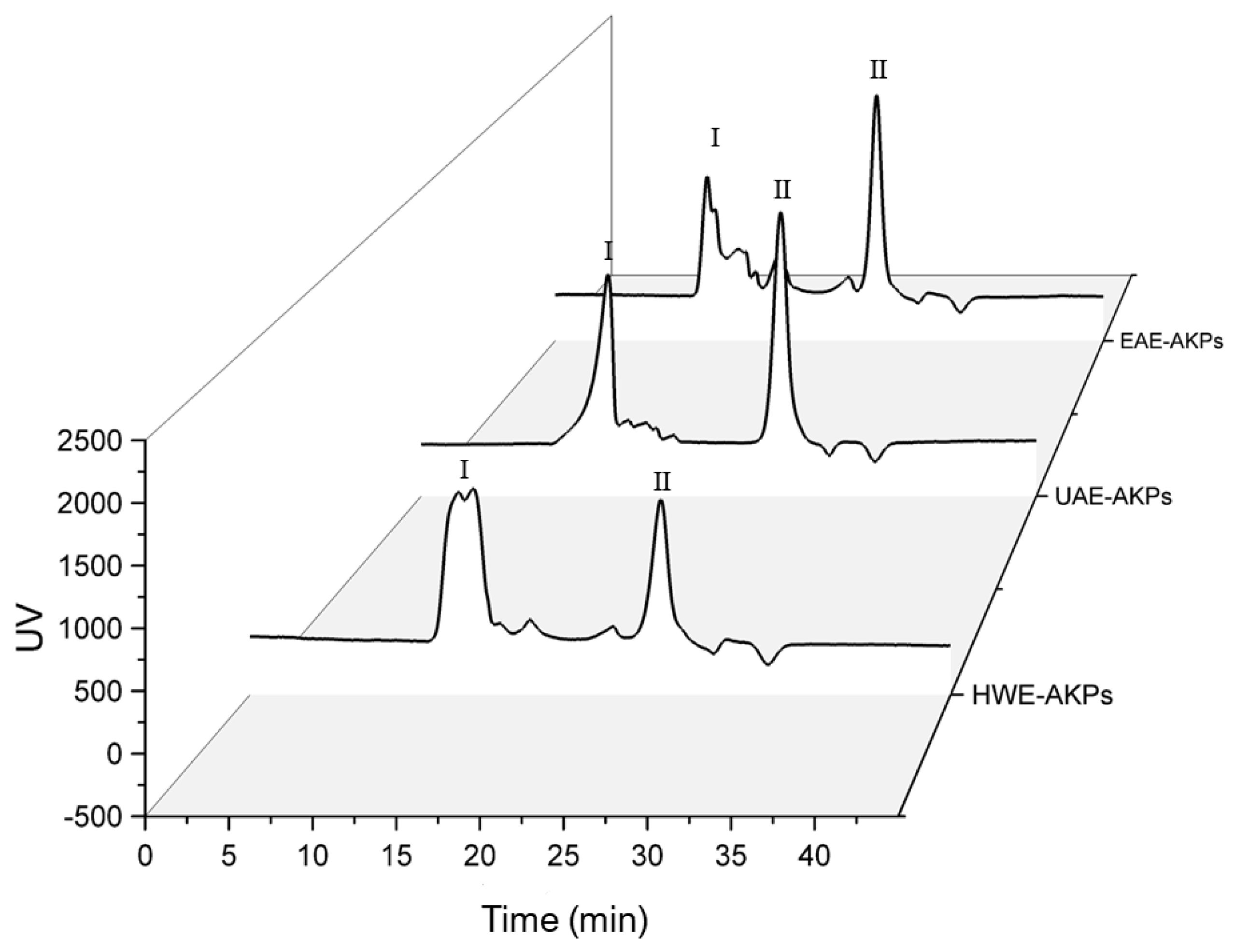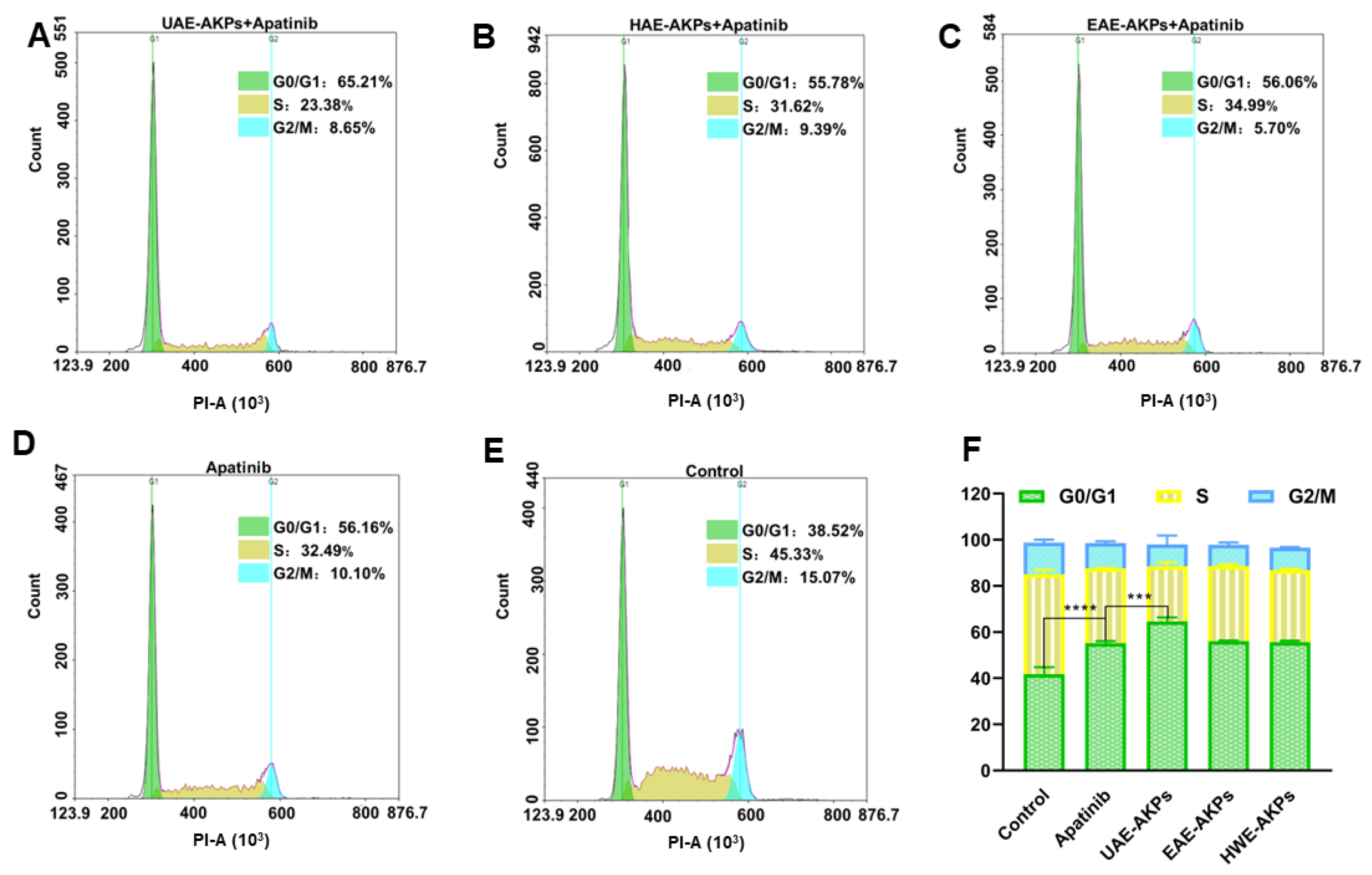A Comparison Study on Polysaccharides Extracted from Atractylodes chinensis (DC.) Koidz. Using Different Methods: Structural Characterization and Anti-SGC-7901 Effect of Combination with Apatinib
Abstract
:1. Introduction
2. Materials and Methods
2.1. Material and Chemical Reagents
2.2. Preparation of AKPs Extracted by Different Methods
2.2.1. Pretreatment of AK
2.2.2. Extraction of AKPs
2.3. Characterization of Different AKPs
2.3.1. Analysis of Ultraviolet-Visible (UV–Vis) Spectroscopy
2.3.2. Analysis of Fourier Transform-Infrared (FT-IR) Spectroscopy
2.3.3. Determination of the Total Carbohydrate Content of AKPs
2.3.4. Determination of the Molecular Weight Distribution of AKPs
2.3.5. Monosaccharide Composition of AKPs
2.4. In Vitro Synergistic Activity Study
2.4.1. Cell Culture
2.4.2. MTT Assay for Cytotoxicity
Cell Cytotoxicity Assay
Analysis of the Synergistic Effect of the Combination Apatinib with AKPs
2.4.3. Cell Cycle Analysis
2.5. Statistical Analysis
3. Results
3.1. Yield and Total Carbohydrate Content of AKPs
3.2. Ultraviolet-visible (UV–Vis) Spectroscopy
3.3. Fourier Transform Infrared Spectroscopy (FI-IR)
3.4. Determination of the Molecular Weight Distribution of AKPs
3.5. Monosaccharide Composition of AKPs
3.6. In Vitro Synergistic Activity Study
3.6.1. Apatinib or AKPs Inhibited Cell Proliferation
3.6.2. AKPs Promoted Apatinib against Cell Proliferation
3.6.3. Effects of AKPs Combined with Apatinib on Cell Cycle
4. Discussion
5. Conclusions
Author Contributions
Funding
Institutional Review Board Statement
Informed Consent Statement
Data Availability Statement
Conflicts of Interest
Sample Availability
References
- He, Y.; Wang, Y.; Luan, F.; Yu, Z.; Feng, H.; Chen, B.; Chen, W. Chinese and global burdens of gastric cancer from 1990 to 2019. Cancer Med. 2021, 10, 3461–3473. [Google Scholar] [CrossRef] [PubMed]
- National Health Commission of the People’s Republic of China. Chinese guidelines for diagnosis and treatment of gastric cancer 2018 (English version). Chin. J. Cancer Res. 2019, 31, 707–737. [Google Scholar] [CrossRef] [PubMed]
- Scott, L.J. Apatinib: A Review in Advanced Gastric Cancer and Other Advanced Cancers. Drugs 2018, 78, 747–758. [Google Scholar] [CrossRef] [PubMed]
- Chao, L.; Qi, J.; Haifeng, W.; Xinghai, Y.; Tielong, L.; Jian, Z.; Yan, L.; Chenguang, W.; Hongyu, Y.; Zhenxi, L.; et al. Apatinib in patients with advanced chordoma: A single-arm, single-centre, phase 2 study. Lancet. Oncol. 2020, 21, 1244–1252. [Google Scholar]
- Shao, F.; Zhang, H.; Yang, X.; Lou, X.; Liu, J. Adverse events and management of apatinib in patients with advanced or metastatic cancers: A review. Neoplasma 2020, 67, 715–723. [Google Scholar] [CrossRef]
- Yang, Y.L.; Lin, Z.W.; He, P.T.; Nie, H.; Zhang, S.Y. Inhibitory effect of Astragalus Polysaccharide combined with cisplatin on cell cycle and migration of nasopharyngeal carcinoma cell lines. Biol. Pharm. Bull. 2021, 44, 926–931. [Google Scholar] [CrossRef]
- Yw, A.; Ll, A.; Yz, A.; Rza, B. Polysaccharides of vinegar-baked radix bupleuri promote the hepatic targeting effect of oxymatrine by regulating the protein expression of HNF4α, Mrp2, and OCT1. J. Ethnopharmacol. 2020, 267, 113471. [Google Scholar]
- Liu, Y.; Qin, H.; Zhong, Y.; Li, S.; Chen, T. Neutral Polysaccharide from Panax notoginseng enhanced cyclophosphamide antitumor efficacy in hepatoma H22-bearing mice. BMC Cancer 2021, 21, 37. [Google Scholar] [CrossRef]
- Li, Y.; Wu, Y.; Xia, Q.; Zhao, Y.; Deng, S. Platycodon grandiflorus enhances the effect of DDP against lung cancer by down regulating PI3K/Akt signaling pathway. Biomed. Pharmacother. 2019, 120, 109496. [Google Scholar] [CrossRef]
- Ahmed, S.; Zhan, C.; Yang, Y.; Wang, X.; Yang, T.; Zhao, Z.; Zhang, Q.; Li, X.; Hu, X. The Transcript Profile of a Traditional Chinese Medicine, Atractylodes lancea, Revealing Its Sesquiterpenoid Biosynthesis of the Major Active Components. PLoS ONE 2016, 11, e0151975. [Google Scholar] [CrossRef]
- Zhang, W.J.; Zhao, Z.Y.; Chang, L.K.; Cao, Y.; Guo, L.P. Atractylodis Rhizoma: A review of its traditional uses, phytochemistry, pharmacology, toxicology and quality control. J. Ethnopharmacol. 2020, 266, 113415. [Google Scholar] [CrossRef] [PubMed]
- Kimura, Y.; Sumiyoshi, M. Effects of an Atractylodes lancea rhizome extract and a volatile component β-eudesmol on gastrointestinal motility in mice. J. Ethnopharmacol. 2012, 141, 530–536. [Google Scholar] [CrossRef] [PubMed]
- Kitajima, J.; Kamoshita, A.; Ishikawa, T.; Takano, A.; Fukuda, T.; Isoda, S.; Ida, Y. Glycosides of Atractylodes japonica. Chem. Pharm. Bull. 2003, 51, 152–157. [Google Scholar] [CrossRef] [Green Version]
- Taguchi, I.; Kiyohara, H.; Matsumoto, T.; Yamada, H. Structure of oligosaccharide side chains of an intestinal immune system modulating arabinogalactan isolated from rhizomes of Atractylodes lancea DC. Carbohydr. Res. 2004, 339, 763–770. [Google Scholar] [CrossRef]
- Qin, J.; Wang, H.Y.; Zhuang, D.; Meng, F.C.; Lv, G.P. Structural characterization and immunoregulatory activity of two polysaccharides from the rhizomes of Atractylodes lancea (Thunb.) DC. Int. J. Biol. Macromol. 2019, 136, 341–351. [Google Scholar] [CrossRef] [PubMed]
- Zhuang, D.; Qin, J.; Wang, H.Y.; Zhang, Y.; Lv, G.P. Oligosaccharide-based quality evaluation of Atractylodis rhizome and a strategy for simplifying its quality control. BMC Chem. 2019, 13, 92. [Google Scholar] [CrossRef] [Green Version]
- Xu, J.; Chen, D.; Liu, C.; Wu, X.Z.; Dong, C.X.; Zhou, J. Structural characterization and anti-tumor effects of an inulin-type fructan from Atractylodes chinensis. Int. J. Biol. Macromol. 2016, 82, 765–771. [Google Scholar] [CrossRef]
- Chen, L.; Huang, G. Antitumor Activity of Polysaccharides: An Overview. Curr. Drug Targets-Int. J. Timely-Depth Rev. Drug Targets 2018, 19, 89–96. [Google Scholar] [CrossRef]
- Duan, M.; Shang, H.; Chen, S.; Li, R.; Wu, H. Physicochemical properties and activities of comfrey polysaccharides extracted by different techniques. Int. J. Biol. Macromol. 2018, 115, 876–882. [Google Scholar] [CrossRef]
- Chen, C.; Wang, P.P.; Huang, Q.; You, L.J.; Liu, R.H.; Zhao, M.M.; Fu, X.; Luo, Z.G. A comparison study on polysaccharides extracted from Fructus Mori using different methods: Structural characterization and glucose entrapment. Food Funct. 2019, 10, 3684–3695. [Google Scholar] [CrossRef]
- Likun, C.; Wenjing, Z.; Ye, C.; Sheng, W.; Chuanzhi, K.; Li, Z.; Quan, Y.; Linangyun, Z.; Lanping, G. Research progress in extraction, isolation, structure analysis and biological activity of Polysaccharide from Atractylodes atractylodes. China J. Chin. Mater. Med. 2021, 46, 2133–2141. [Google Scholar]
- Maran, J.P.; Priya, B. Ultrasound-assisted extraction of polysaccharide from Nephelium lappaceum L. fruit peel. Int. J. Biol. Macromol. Struct. Funct. Interact. 2014, 70, 530–536. [Google Scholar] [CrossRef] [PubMed]
- Chen, S.; Shang, H.; Yang, J.; Li, R.; Wu, H. Effects of different extraction techniques on physicochemical properties and activities of polysaccharides from comfrey (Symphytum officinale L.) root. Ind. Crops Prod. 2018, 121, 18–25. [Google Scholar] [CrossRef]
- Yuxiu, Z.; Guijuan, L. Process optimization and antioxidant properties of Atractylodes macrocephala polysaccharide extraction by orthogonal experimental method. Guangdong Chem. 2019, 46, 58–60. [Google Scholar]
- Lina, M.; Jing, X. Optimization of ultrasonic extraction of Atractylodes chinensis (DC.) Koidz polysaccharide by orthogonal experiment. Mod. Drugs Clin. 2012, 27, 457–460. [Google Scholar]
- Junmin, Z.; Gang, S. Study on the optimum technological conditions for enzymatic extraction of Atractylodes lancea (Thunb.) DC. polysaccharide. Chin. Pat. Med. 2014, 36, 1088–1090. [Google Scholar]
- Wang, Y.; Guo, M. Purification and structural characterization of polysaccharides isolated from Auricularia cornea var. Li. Carbohydr. Polym. 2019, 230, 115680. [Google Scholar] [CrossRef]
- Minjares-Fuentes, R.; Femenia, A.; Comas-Serra, F.; Rosselló, C.; Rodríguez-González, V.M. Effect of different drying procedures on physicochemical properties and flow behavior of Aloe vera (Aloe barbadensis Miller) gel. LWT-Food Sci. Technol. 2016, 74, 378–386. [Google Scholar] [CrossRef]
- Dubios, M.; Gilles, K.; Hamilton, J.K.; Rebers, P.A.; Smith, F. Colorimetric method for determination of sugar and related substances. Anal. Chem. 1956, 28, 250–256. [Google Scholar] [CrossRef]
- Chen, C. Optimization for ultrasound extraction of polysaccharides from mulberry fruits with antioxidant and hyperglycemic activity in vitro. Carbohydr. Polym. 2015, 130, 122–132. [Google Scholar] [CrossRef]
- Xie, J.H.; Xin, L.; Shen, M.Y.; Nie, S.P.; Hui, Z.; Li, C.; Gong, D.M.; Xie, M.Y. Purification, physicochemical characterisation and anticancer activity of a polysaccharide from Cyclocarya paliurus leaves. Food Chem. 2013, 136, 1453–1460. [Google Scholar] [CrossRef] [PubMed]
- Wu, Z.; Sun, H.; Li, J.; Ma, C.; Zhao, S.; Guo, Z.; Lin, Y.; Lin, Y.; Liu, L. A polysaccharide from Sanguisorbae radix induces caspase-dependent apoptosis in human leukemia HL-60 cells. Int. J. Biol. Macromol. 2014, 70, 615–620. [Google Scholar] [CrossRef] [PubMed]
- Chen, G.; Fang, C.; Ran, C.X.; Tan, Y.; Yu, Q.; Kan, J. Comparison of different extraction methods for polysaccharides from bamboo shoots (Chimonobambusa quadrangularis) processing by-products. Int. J. Biol. Macromol. 2019, 130, 903–914. [Google Scholar] [CrossRef] [PubMed]
- Hammi, K.M.; Hammami, M.; Rihouey, C.; Le Cerf, D.; Ksouri, R.; Majdoub, H. Optimization extraction of polysaccharide from Tunisian Zizyphus lotus fruit by response surface methodology: Composition and antioxidant activity. Food Chem. 2016, 212, 476–484. [Google Scholar] [CrossRef] [PubMed]
- Filgueiras, A.V.; Capelo, J.L.; Lavilla, I.; Bendicho, C. Comparison of ultrasound-assisted extraction and microwave-assisted digestion for determination of magnesium, manganese and zinc in plant samples by flame atomic absorption spectrometry. Talanta 2000, 53, 433–441. [Google Scholar] [CrossRef]
- Lian, H.; Yan, X.; Jian, L.; Li, S.; He, H.; Xiong, Q.; Lai, X.; Hou, S.; Song, H. Comparison of different extraction methods for polysaccharides from Dendrobium officinale stem. Carbohydr. Polym. 2018, 198, 101–108. [Google Scholar]
- Fang, C.; Chen, G.; Kan, J. Comparison on characterization and biological activities of Mentha haplocalyx polysaccharides at different solvent extractions. Int. J. Biol. Macromol. 2020, 154, 916–928. [Google Scholar] [CrossRef]
- Cui, J.; Gu, X.; Wang, F.; Ouyang, J.; Wang, J. Purification and structural characterization of an α-glucosidase inhibitory polysaccharide from apricot (Armeniaca sibirica L. Lam.) pulp. Carbohydr. Polym. 2015, 121, 309–314. [Google Scholar] [CrossRef]
- Alvarado-Morales, G.; Minjares-Fuentes, R.; Contreras-Esquivel, J.C.; Montañez, J.; Meza-Velázquez, J.A.; Femenia, A. Application of thermosonication for Aloe vera (Aloe barbadensis Miller) juice processing: Impact on the functional properties and the main bioactive polysaccharides. Ultrason. Sonochemistry 2019, 56, 125–133. [Google Scholar] [CrossRef]
- Wang, Y.; Li, Y.; Ma, X.; Ren, H.; Fan, W.; Leng, F.; Yang, M.; Wang, X. Extraction, purification, and bioactivities analyses of polysaccharides from Glycyrrhiza uralensis. Ind. Crops Prod. 2018, 122, 596–608. [Google Scholar] [CrossRef]
- Feng, S.; Cheng, H.; Fu, L.; Ding, C.; Zhang, L.; Yang, R.; Zhou, Y. Ultrasonic-assisted extraction and antioxidant activities of polysaccharides from Camellia oleifera leaves. Int. J. Biol. Macromol. 2014, 68, 7–12. [Google Scholar] [CrossRef] [PubMed]
- Zhang, J.C.; Liu, Y.; Sun, H.J.; Wang], J.H. Rheological properties of a polysaccharide from floral mushrooms cultivated in Huangshan Mountain. Carbohydr. Polym. 2016, 139, 43–49. [Google Scholar]
- Ghafoor, K.; Ozcan, M.M.; AL-Juhaimi, F.; Babiker, E.E.; Sarker, Z.I.; Ahmed, I.A.M.; Ahmed, M.A. Nutritional composition, extraction, and utilization of wheat germ oil: A review. Eur. J. Lipid Sci. Technol. 2017, 119, 1600160. [Google Scholar] [CrossRef]
- Tang, Y.; Zhu, Z.Y.; Pan, L.C.; Sun, H.; Song, Q.Y.; Zhang, Y. Structure analysis and anti-fatigue activity of a polysaccharide from Lepidium meyenii Walp. Nat. Prod. Res. 2018, 33, 1. [Google Scholar] [CrossRef]
- Liao, W.; Luo, Z.; Liu, D.; Ning, Z.; Yang, J.; Ren, J. Structure Characterization of a Novel Polysaccharide from Dictyophora indusiata and Its Macrophage Immunomodulatory Activities. J. Agric. Food Chem. 2015, 63, 535–544. [Google Scholar] [CrossRef]
- Rodríguez-González, V.; Femenia, A.; González-Laredo, R.; Rocha-Guzmán, N.; Gallegos-Infante, J.A.; Candelas-Cadillo, M.G.; Ramírez-Baca, P.; Simal, S.; Rosselló, C. Effects of pasteurization on bioactive polysaccharide acemannan and cell wall polymers from Aloe barbadensis Miller. Carbohydr. Polym. 2011, 86, 1675–1683. [Google Scholar] [CrossRef]
- Chen, G.T.; Yuan, B.; Wang, H.X.; Qi, G.; Cheng, S.J. Characterization and antioxidant activity of polysaccharides obtained from ginger pomace using two different extraction processes. Int. J. Biol. Macromol. 2019, 139, 801–809. [Google Scholar] [CrossRef]
- Hulle, N.R.S.; Patruni, K.; Rao, P.S. Rheological Properties of Aloe Vera (Aloe barbadensis Miller) Juice Concentrates. J. Food Process Eng. 2014, 37, 375–386. [Google Scholar] [CrossRef]
- Zhu, Z.Y.; Pang, W.; Li, Y.Y.; Ge, X.R.; Chen, L.J.; Liu, X.C.; Lv, Q.; Dong, G.L.; Liu, A.J.; Zhang, Y. Effect of ultrasonic treatment on structure and antitumor activity of mycelial polysaccharides from Cordyceps gunnii. Carbohydr. Polym. 2014, 114, 12–20. [Google Scholar] [CrossRef]
- Li, X.; Wang, L. Effect of extraction method on structure and antioxidant activity of Hohenbuehelia serotina polysaccharides. Int. J. Biol. Macromol. 2016, 83, 270–276. [Google Scholar] [CrossRef]
- Chen, S.; Chen, H.; Tian, J.; Wang, J.; Wang, Y.; Xing, L. Enzymolysis-ultrasonic assisted extraction, chemical characteristics and bioactivities of polysaccharides from corn silk. Carbohydr. Polym. 2014, 101, 332–341. [Google Scholar] [CrossRef] [PubMed]
- Wang, Y.-Q.; Mao, J.-B.; Zhou, M.-Q.; Jin, Y.-W.; Lou, C.-H.; Dong, Y.; Shou, D.; Hu, Y.; Yang, B.; Jin, C.-Y.; et al. Polysaccharide from Phellinus Igniarius activates TLR4-mediated signaling pathways in macrophages and shows immune adjuvant activity in mice. Int. J. Biol. Macromol. 2019, 123, 157–166. [Google Scholar] [CrossRef] [PubMed]
- Zhang, Y.; Gu, P.; Wusiman, A.; Xu, S.; Ni, H.; Qiu, T.; Liu, Z.; Hu, Y.; Liu, J.; Wang, D. The Immunoenhancement Effects of Polyethylenimine-Modified Chinese Yam Polysaccharide-Encapsulated PLGA Nanoparticles as an Adjuvant. Int. J. Nanomed. 2020, 2020, 5527–5543. [Google Scholar] [CrossRef] [PubMed]
- Zhao, C.; Li, X.; Miao, J.; Jing, S.; Gao, W. The effect of different extraction techniques on property and bioactivity of polysaccharides from Dioscorea hemsleyi. Int. J. Biol. Macromol. 2017, 102, 847–856. [Google Scholar] [CrossRef]
- Li, M.; Yan, D.; Hu, X.; Ren, G.; Zhu, X.; Wang, Z.; Teng, Z.; Wu, R.; Wu, J. Structural, rheological properties and antioxidant activities of polysaccharides from mulberry fruits (Murus alba L.) based on different extraction techniques with superfine grinding pretreatment. Int. J. Biol. Macromol. 2021, 183, 1774–1783. [Google Scholar] [CrossRef] [PubMed]
- He, Y.; Cao, X.; Kong, Y.; Wang, S.; Liu, J. Apoptosis-promoting and migration-suppressing effect of alantolactone on gastric cancer cell lines BGC-823 and SGC-7901 via regulating p38MAPK and NF-κB pathways. Hum. Exp. Toxicol. 2019, 38, 096032711985512. [Google Scholar] [CrossRef]
- Wang, Y.; Zhang, X.; Zheng, Y.; Xie, W.; Wang, D.; Li, X.; Sun, C.; Chen, K. The growth of SGC-7901 tumor xenografts was suppressed by Chinese bayberry anthocyanin extract through upregulating KLF-6 gene expression. Nutrients. 2016, 8, 599. [Google Scholar] [CrossRef] [Green Version]
- Qi, H.; Zhang, Q.; Zhao, T.; Chen, R.; Hong, Z.; Niu, X.; Li, Z. Antioxidant activity of different sulfate content derivatives of polysaccharide extracted from Ulva pertusa (Chlorophyta) in vitro. Int. J. Biol. Macromol. 2005, 37, 195–199. [Google Scholar] [CrossRef]
- Cao, J.J.; Lv, Q.Q.; Zhang, B.; Chen, H.Q. Structural characterization and hepatoprotective activities of polysaccharides from the leaves of Toona sinensis (A. Juss) Roem. Carbohydr. Polym. 2019, 212, 89–101. [Google Scholar] [CrossRef]
- Lu, J.; You, L.; Lin, Z.; Zhao, M.; Cui, C. The antioxidant capacity of polysaccharide from Laminaria japonica by citric acid extraction. Int. J. Food Sci. Technol. 2013, 48, 1352–1358. [Google Scholar] [CrossRef]
- Usoltseva, R.V.; Anastyuk, S.D.; Surits, V.V.; Shevchenko, N.M.; Thinh, P.D.; Zadorozhny, P.A.; Ermakova, S.P. Comparison of structure and in vitro anticancer activity of native and modified fucoidans from Sargassum feldmannii and S. duplicatum. Int. J. Biol. Macromol. 2019, 124, 220–228. [Google Scholar] [CrossRef] [PubMed]





| Methods | UAE | HWE | EAE |
|---|---|---|---|
| Water to raw material ratio (mL/g) | 20:1 | 20:1 | 20:1 |
| extraction duration (min) | 40 | 240 | 92 |
| Extraction temperature (°C) | 60 | 90 | 53 |
| Ultrasonic Power (W) | 160 | / | / |
| Condition | PH = 7 | PH = 7 | 1.2% complexenzyme; PH = 5 |
| Extraction quality of polysaccharides (g) | 3.27 | 13.44 | 2.125 |
| Extraction rate of polysaccharides (%) | 3.27 | 13.44 | 2.125 |
| Total sugar of polysaccharides (%) | 93.98 | 91.12 | 96.85 |
| Monosaccharide Composition (%) | UAE-AKPs | HWE-AKPs | EAE-AKPs |
|---|---|---|---|
| Mannose (Man) | 0.17 | 4.12 | 0.11 |
| Glucuronic acid (GlcA) | 0.86 | 0.33 | 0.67 |
| Rhamnose (Rha) | 0.50 | 0.83 | 1.41 |
| Galacturonic acid (GalA) | 0.05 | 3.67 | 16.46 |
| Glucose (Glu) | 17.92 | 28.86 | 4.78 |
| Galactose (Gal) | 22.80 | 7.54 | 12.65 |
| Arabinose (Ara) | 57.70 | 54.65 | 64.02 |
Publisher’s Note: MDPI stays neutral with regard to jurisdictional claims in published maps and institutional affiliations. |
© 2022 by the authors. Licensee MDPI, Basel, Switzerland. This article is an open access article distributed under the terms and conditions of the Creative Commons Attribution (CC BY) license (https://creativecommons.org/licenses/by/4.0/).
Share and Cite
Zhou, P.; Xiao, W.; Wang, X.; Wu, Y.; Zhao, R.; Wang, Y. A Comparison Study on Polysaccharides Extracted from Atractylodes chinensis (DC.) Koidz. Using Different Methods: Structural Characterization and Anti-SGC-7901 Effect of Combination with Apatinib. Molecules 2022, 27, 4727. https://doi.org/10.3390/molecules27154727
Zhou P, Xiao W, Wang X, Wu Y, Zhao R, Wang Y. A Comparison Study on Polysaccharides Extracted from Atractylodes chinensis (DC.) Koidz. Using Different Methods: Structural Characterization and Anti-SGC-7901 Effect of Combination with Apatinib. Molecules. 2022; 27(15):4727. https://doi.org/10.3390/molecules27154727
Chicago/Turabian StyleZhou, Pingfan, Wanwan Xiao, Xiaoshuang Wang, Yayun Wu, Ruizhi Zhao, and Yan Wang. 2022. "A Comparison Study on Polysaccharides Extracted from Atractylodes chinensis (DC.) Koidz. Using Different Methods: Structural Characterization and Anti-SGC-7901 Effect of Combination with Apatinib" Molecules 27, no. 15: 4727. https://doi.org/10.3390/molecules27154727
APA StyleZhou, P., Xiao, W., Wang, X., Wu, Y., Zhao, R., & Wang, Y. (2022). A Comparison Study on Polysaccharides Extracted from Atractylodes chinensis (DC.) Koidz. Using Different Methods: Structural Characterization and Anti-SGC-7901 Effect of Combination with Apatinib. Molecules, 27(15), 4727. https://doi.org/10.3390/molecules27154727





